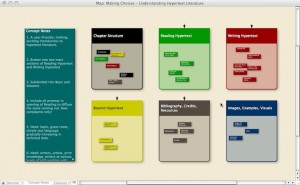HYPERTEXT PROJECT 2: Learning to Love It
I’ve been working in Tinderbox and Storyspace for literary purposes for a few years now. I’ve had a hypertext story published in The New River Review and my 100 Days Project of 100 Hypertext stories has been listed in the Electronic Literature Organization Directory. It’s not much, but it’s a start. Towards what goal? Well, to spread the word, to gain audience, to prove that hypertext is coming of age in a world where reading is done to a great degree online, and where hypertext literature is not only perfect for the times, it is ahead of them yet oddly it remains largely unacknowledged by both academia and the general reading population.
 What then, to do? Make it lovable. So that’s the project. Here’s the start:
What then, to do? Make it lovable. So that’s the project. Here’s the start:
From personal experience, including my own baptism into hypertext waters, and here, years later, reading the reaction of students being exposed to the medium, I’ve got to admit that the initial reaction is generally either “Yuck, I don’t see its purpose, it’s confusing” or “Wow, that’s great (but I’ll never read another one after this course is over).” So then the problem appears to be primarily in its introductory phase.
There are two problems here that I see. First, not all university courses include a new media course or even much of an inclusion in their literary courses. Secondly, since hypertext is supposedly a break from traditional reading (how is that, when links are clicked to read online so often that there’s a perceptible new “white noise” hum in the atmosphere?) it’s bound to hit resistance. Folks like ease and speed these days. Hypertext is not necessarily meant to be read fast and easy. Reading literature itself should be tough, unless we’re seeking mindless, non-demanding entertainment. And escapism for its own sake is fine; I do it all the time, only not in hypertext literature.
This is an undertaking that I’m hot on, have been for years, yet never had time to kick off. Now, I’m going to make it a part of my daily writing. It will of necessity include some team effort, people who are more skilled with the medium and have the technological know-how to produce what I clearly cannot. That’s all a part of the plan.
Then again, am I being too pushy in my attempts to be helpful? Maybe. So what?

 The Lost Children: A Charity Anthology
The Lost Children: A Charity Anthology
October 6th, 2010 at 10:39 am
Could you write about how you use Tinderbox and Storyspace differently? When would you use one? And when the other?
October 6th, 2010 at 11:53 am
Well, basically, I started on Storyspace since Tinderbox is not available for PC, then switched to Tinderbox when I became Mac. Storyspace is plenty enough for writing narrative, including images, and transferring into html format to be read online. The one thing that’s great about Storyspace that Tinderbox currently does not have, are “guard fields” which maneuver the reading so that a space need not be visited again, but the reader instead is directed to a new path. This is not available in Tinderbox, however, the guard fields are not able (without a lot of extra coding) to be exported online anyway. On the other hand, Tinderbox currently does not have the ability to included images, but that can be overcome in the html page coding after export. Tinderbox also has extensive capability beyond Storyspace for non-narrative purposes, although if a longer piece (novel) were written, the Agents, Attributes, grant the writer a form of organization that Storyspace cannot offer. Overall, I strictly use Tinderbox now. If you’d like more information on my personal experience with either, visit the Tags of Each on the right-hand sidebar, and feel free to ask anything you feel I could answer or be of help on this.